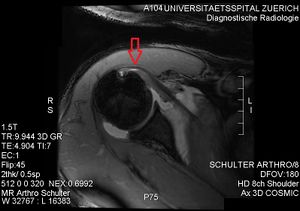Gerbers Test
Purpose[edit | edit source]
Gerber's test is also known as Lift-Off Test (LOT) or Gerber's Lift-Off Test. It was first described by Gerber and Krushell(199l)[1]. It was developed to be used as a simple clinical maneuver, which can reliably diagnose or exclude clinically relevant rupture of the subscapularis tendon.
The Subscapularis is part of the 4 muscles, called the rotator cuff, which provides stability and strength to the shoulder joint during motion. The other 3 muscles include The Supraspinatus, The Infraspinatus, and The Teres Minor. Each of these muscles has its own special tests to check their integrity and functioning.
Another clinical test for the subscapularis was also described by Gerber et al in 1996, called the Belly Press Test (BPT) in response to patients who were unable to perform the LOT because of pain or limited joint range of motion
Technique[edit | edit source]
To perform this test, the patient is asked to place the back of the affected arm in the mid lumbar spine area. The testing movement involves the patient performing internal rotation (IR), by lifting the hand off the back while the examiner places pressure on the hand[2].
The test is considered to be positive if the patient cannot resist, lift the hand off the back or if she/he compensates by extending the elbow and shoulder[2].
Evidence[edit | edit source]
Provide the evidence for this technique here
Resources[edit | edit source]
add any relevant resources here
https://cdn.mdedge.com/files/s3fs-public/Document/September-2017/5507JFP_ClinicalInquiries1.pdf
https://www.sciencedirect.com/science/article/pii/S1877056812002289
https://www.archives-pmr.org/action/showPdf?pii=S0003-9993%2803%2900977-8
https://www.archives-pmr.org/action/showPdf?pii=S0003-9993%2811%2900795-7
References[edit | edit source]
- ↑ Gerber C and Krushell RJ. Isolated rupture of the tendon of the subscapularis muscle. Clinical features in 16 cases. The Journal of Bone and Joint Surgery. British volume 1991 73-B:3, 389-394
- ↑ 2.0 2.1 J. Barth, S. Audebert, B. Toussaint, C. Charousset, A. Godeneche, N. Graveleau, T. Joudet, Y. Lefebvre, L. Nove-Josserand, E. Petroff, N. Solignac, C. Scymanski, M. Pitermann, C.-E. Thelu. Diagnosis of subscapularis tendon tears: Are available diagnostic tests pertinent for a positive diagnosis?, Orthopaedics & Traumatology: Surgery & Research, 2012, Volume 98, Issue 8, Supplement, Pages S178-S185,
- ↑ Examination of the Rotator Cuff - Lift-off Test - Clinical Examination. Available from: http://www.youtube.com/watch?v=t9dSDVRbjn0
| The content on or accessible through Physiopedia is for informational purposes only. Physiopedia is not a substitute for professional advice or expert medical services from a qualified healthcare provider. Read more. |







